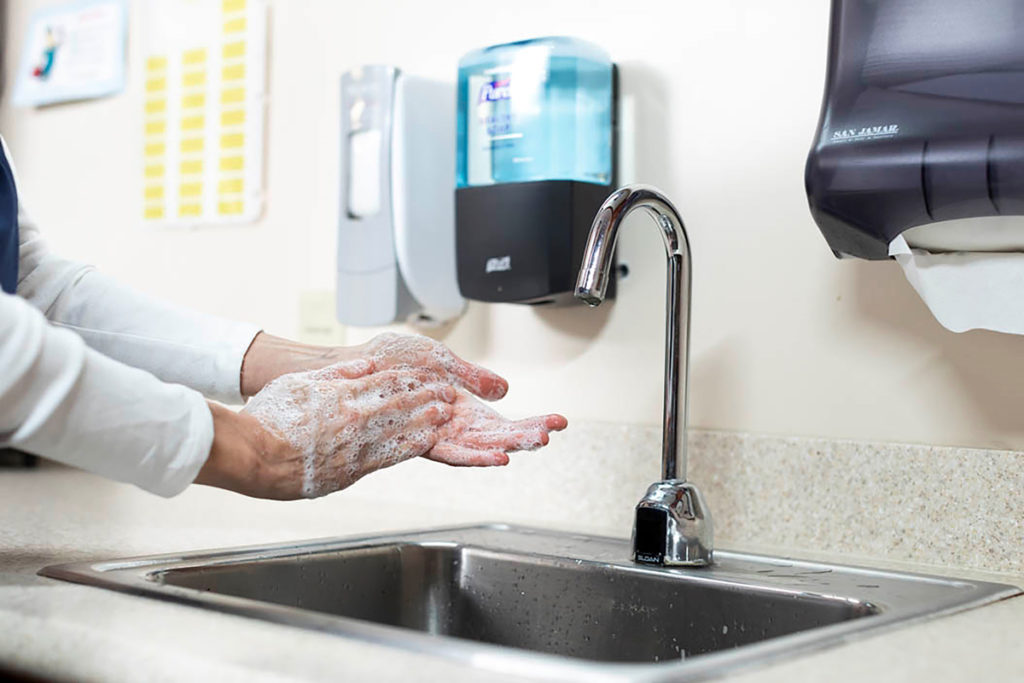Prior to publication of the 2002 Centers for Disease Control and Prevention (CDC) hand hygiene guidelines,
soap was the predominant hand hygiene product. While alcohol-based hand rub (ABHR) is the primary pillar of hand hygiene today, washing hands with soap and water is recommended primarily when hands are visibly soiled or contaminated with blood or other bodily fluids and when there are outbreaks of Clostridium difficile or norovirus.1 Soap is still a critical part of hand hygiene in healthcare settings and is often not always given as much consideration as it deserves. Soap can have an impact on healthcare workers’ (HCW) skin health. That’s why it’s important to understand how soap works and how choosing a properly formulated soap can make all the difference in helping to maintain proper skin health and giving safer patient care.
Choosing a soap
The general mechanism of action is lifting and suspending oil, dirt, and other organic substances from hands so they can be rinsed down the drain, much like cleaning a dirty dish. Soaps are classified as surfactants (surface active agents) that possess both polar (ionic/hydrophilic) and non-polar (long hydrocarbon/hydrophobic) groups. A soap molecule has a polar head that is water-loving and a non-polar tail that is oil-loving. When water is added, the soap molecules aggregate into tiny formed clusters called micelles. When this happens all the non-polar (oil-loving) tails line up on the inside, excluding the water and attracting the oil and dirt to the inside of the micelle and suspending it there. The polar heads align on the outside of the micelles where the water is and allow the suspended dirt and oil to be washed down the drain. As a result, soaps are capable of cleaning skin and other substrates by removing both water soluble and water-insoluble dirt from the substrates and suspending them in aqueous, or water-like, solutions.
When choosing between a plain or non-antimicrobial and antimicrobial soap it is important to understand the key differences. With non-antimicrobial soaps, organic substances and some germs are removed by simply using friction from rubbing hands together. This action helps loosen up the bacteria and soils on the hands, allowing them to be rinsed down the drain. With an antimicrobial soap, the same physical mechanism of action for removing germs and soils happens, and any bacteria or germs present are exposed to the antimicrobial active ingredient which attaches to the germs and kills them. The CDC hand hygiene guidelines allow the use of either an antimicrobial or a non-antimicrobial soap. One is not recommended over the other in healthcare.
Understanding the anatomy of skin
To understand how hand hygiene products affect the skin, it is important to understand a little about the anatomy of skin. The top layer of skin, known as the stratum corneum, is made up of mostly dead skin cells, lipids, oils and corneocytes. This paper-thin structure serves as the primary barrier between the body and the environment. Its primary function is to protect the body and to prevent loss of water. The stratum corneum has a brick-and-mortar structure that is tightly packed together to form your skin barrier. When washing your hands with soap the micelles attract oils and lipids, as previously mentioned, but they are also attracting and removing the oils and lipids from this top layer of your skin. As these lipids are removed from your skin, they can leave gaps in the brick-and-mortar structure through which allergens and germs can to enter. This interruption of the skin’s barrier happens when a HCW over-uses soap and water to clean their hands, and can happen faster if warm or hot water is used when washing. Think of washing butter (similar to the skin’s “mortar”) off of a dinner plate at home. Therefore, it is also important to use cool or lukewarm water when washing hands with soap and water.
Given the impact of soap on the skin, it is critical for healthcare facilities to choose a soap that has been formulated for high in-use settings. Not all soaps are created equal and poorly formulated soaps can be very harsh on the skin, setting up a vicious dry skin cycle that worsens with each soap handwash. In the past, antimicrobial soaps have been less mild to skin than non-antimicrobial soaps; however, the latest generation of antimicrobial soaps can provide both antimicrobial efficacy and improved skin mildness. While there is not specific guidance on the use of either an antimicrobial or a non-anti-microbial soap, it is critical to choose a well-formulated soap with low potential for irritation to help mitigate skin health issues. Selecting the right soap may not be easy, but being well-informed about the options and key selection factors can help make the process easier.
1. Dubberke ER, Carling P, Carrico R, et al; Society for Healthcare Epidemiology of America. Strategies to prevent Clostridium difficile infections in acute care hospitals: 2014 update. Infect Control Hosp Epidemiol. 2014;35(6):628-645.
Sidebar:
Key points
It’s important to understand the key differences between a plain or non-antimicrobial and antimicrobial soap:
- With non-antimicrobial soaps, organic substances and some germs are removed by simply using friction from rubbing hands together. This action helps loosen up the bacteria and soils on the hands, allowing them to be rinsed down the drain.
- With an antimicrobial soap, the same physical mechanism of action for removing germs and soils happens, and any bacteria or germs present are exposed to the antimicrobial active ingredient which attaches to the germs and kills them.
